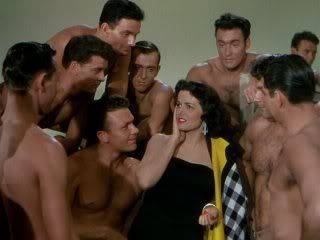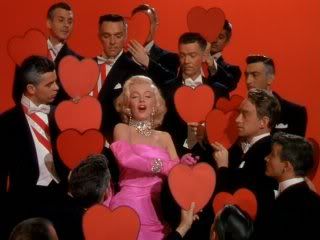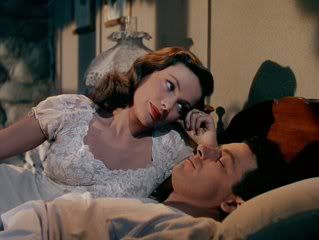Men are the same way everywhere.


Attended a memorial service this afternoon for pioneering queer cinema scholar Alexander Doty, which was followed by screenings of two of his favorite films. First up was 1953's Gentlemen Prefer Blondes, which I've been meaning to see ever since I read about it in Danny Peary's Cult Movies 3. Directed by Howard Hawks, it was the only on-screen pairing of Jane Russell, who's top-billed, and Marilyn Monroe, who was on the verge of becoming the biggest star of the decade. And while Monroe is luminous as the lanky Lorelei Lee, a gold-digger who's hooked a rich fish and does whatever she can to keep him hooked, I was much more taken with Russell's down-to-earth Dorothy Shaw, Lorelei's sharp-witted friend and confidante who really got my attention with her splashy musical number, "Ain't Anyone Here for Love?" Sure, this is the film with Monroe's justly famous rendition of "Diamonds Are a Girl's Best Friend," but I watched Madonna's "Material Girl" music video too many times in my youth for it to have the same kind of impact.
As for the wisp of a plot, the bulk of it is set aboard a boat bound for Paris, where Monroe plans to lure her rich suitor (Tommy Noonan) away from his disapproving father, who has hired a private detective (Elliott Reid) to check up on her. In the process of discharging his duties, Reid rubs shoulders with Russell, who's on the rebound after being passed over by the U.S. Olympic team, and takes some incriminating photos of Monroe in a clinch with diamond magnate Charles Coburn. It's all very innocent, of course, but Monroe is going to need all the help she can get -- and all that Russell is able to provide -- to head off disaster. This even extends to Russell's uncanny Monroe impersonation, which is easily the comic highlight of the film. Gentlemen may prefer blondes, but I know where my loyalties lie.

Next up was Fox's Technicolor noir Leave Her to Heaven, in which the beautifully batty Gene Tierney sets her sights on rugged novelist Cornel Wilde and, once she's bagged him, does everything in her power to keep him all to herself. If this means abruptly tossing aside her fiancé, district attorney Vincent Price, so be it. If it also means taking Wilde's crippled kid brother Darryl Hickman out of the picture, then that's copacetic as well. Unfortunately, her possessive side is a real turn-off for Wilde, and it isn't long before he starts spending an inordinate amount of time with her adopted sister, Jeanne Crain...
In addition to being shot in color, 1945's Leave Her to Heaven is an atypical noir in a few other respects, chief among them the way its action unfolds in predominantly rural settings. Director John M. Stahl is also not shy about amping up the melodrama, which really comes to the fore in the courtroom showdown between Wilde and Price, who apparently hasn't gotten over being dropped like a sack of potatoes. To be perfectly frank, I'm surprised Price is allowed to get away with some of his theatrics, especially considering his obvious -- and acknowledged -- personal interest in the case, but I guess judges were more indulgent about that sort of thing back then.